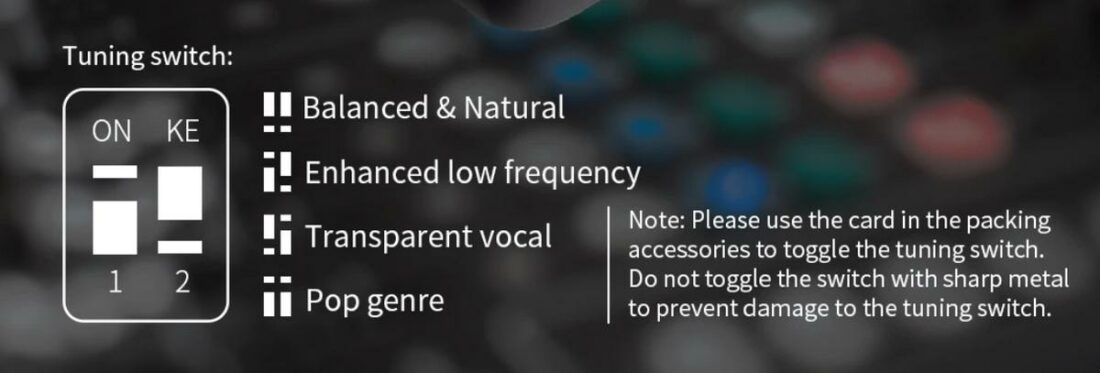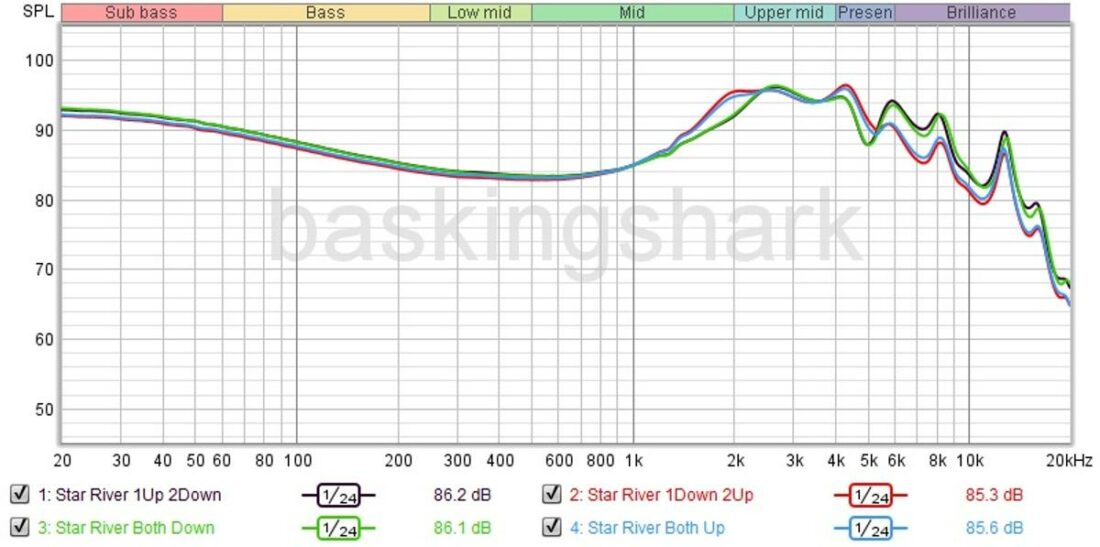The Star River leave a lot to be desired when it comes to the sound, and half of the tuning switch positions do nothing.
If last year was the year of the planar frenzy, 2023 is the year of the dual dynamic driver. Sets such as the TRN TA3, 7Hz Legato, and QKZ x HBB Khan have captured the hearts and minds of audiophiles with GAS (gear acquisition syndrome).
Many tunable transducers have also come out of the woodwork in recent months, with IEMs such as the Simgot EA500 and TRN MT1 Max drawing much interest on forums.
- Moderately easy to drive
- Decent accessories
- Beautiful shells
- Acceptable imaging
- Switches are shenanigans
- QC issues
- Not the most comfortable
- Tangly and microphonic stock cable
- Average isolation
- Second-rate technicalities (other than imaging)
- Hot upper mids
- Unnatural timbre
Waifus, Harman-esque graphs, and collabs are now passe!
Well, what better way to amalgamate these two hype trains than to combine a dual DD transducer with tuning switches? Indeed, that’s what TRI attempted with the Star River, and it is no hyperbole to say that this is uncharted waters for a manufacturer.
Company Overview
TRI Audio is the premium wing of KBEAR. While KBEAR targets the budget market, the former primarily focuses on the higher-end segment.
The I4 – released in 2019 – was the company’s first pair of IEMs. Some crowd favorites have since been released, such as the Meteor, I3, I3 Pro, Starlight, and Starsea.
TRI has also entered the DAP marketplace with the TRI TK2

Technical Specifications
- Form: IEMs
- Drivers: 1 x 10mm beryllium-plated dynamic driver, 1 x 6mm titanium dynamic driver
- Impedance (Ohm): 32Ω
- Sensitivity (dB): 110dB
- Frequency Response (Hz): 20Hz – 20kHz
- Removable Cable: Y
- Cable: 5N oxygen-free copper-plated silver
- Source Plug: 3.5mm single-ended or 4.4mm balanced
- Cup/Shell Plug: 0.78mm, 2-Pin
Packaging

In the box
- TRI Star River IEMs
- 3 pairs of narrow-bore silicone ear tips (S, M, L)
- 3 pairs of wide-bore TRI Clarion silicone ear tips
- Cable
- Carrying case
- Card pin
- Cleaning cloth
The accessories are decent enough for something retailing for sub-USD$60.

Of the two silicone tips provided, the black (narrow-bore) ones increase bass, though they compress the soundstage somewhat. The white Clarion tips have a wider bore and are more balanced – they also boost soundstage and treble.
Cable
The four-core, Litz braided, 5N oxygen-free, copper-plated silver cable is thin and tangly, with some microphonics. There’s a chin cinch for added stability during use.
Consumers can choose between a 4.4mm (balanced) or 3.5mm (single-ended) cable when ordering.

2-pin connectors are always welcome in my book, as they tend to be more robust than MMCX when it comes to frequent cable swapping.
Case

A semi-rigid zipper carrying case is provided. It has internal webbing and is pretty serviceable. There’s also a cleaning cloth for wiping down equipment.
Design

The housings feature an exquisite marble star-like motif, in keeping with their namesake. The shells are fashioned from high-precision, 3D printed, non-allergenic resin from Germany via a seamless reverse molding process.

Strangely, the shells do not have any lettering to identify left from right. Experienced ChiFI aficionados should have no issues identifying sides, but those newer to the hobby might face difficulties.

The sides of the earpieces house tuning switches, and the card pin is needed to flip these. The switches on one of my earpieces are so stiff that they require great force to toggle. The QC for my pair of Star River seems dead in the water, and I doubt that the switches will survive many more manipulations.
Comfort
Marketing documents state that the Star River housings are designed using an accumulation of data points and anatomical studies. They also integrate a unique pressurization chamber. There may be a grain of truth, as I do not encounter any driver flex in my set.
Comfort leaves a lot to be desired.
Though the shells are light without awkward protrusions, I feel some tenderness with longer listening sessions, as the shells are huge.
The Star River are heavily vented, and isolation takes a hit.
Internals
Riding on the aforementioned dual DD hype-train, the Star River utilize a 10mm beryllium-plated dynamic driver in tandem with a smaller 6mm titanium dynamic driver. These are arranged in a parallel precision circuit, with N52 magnets and Japanese voice coils.
Beryllium has desirable properties, light yet elastic, allowing drivers to be rigid and rugged. TRI advertises that this beryllium DD generates a 1 Tesla magnetic flux, thus bestowing a clean sound with minimal distortion.
TRI says the 6mm titanium DD adds clarity and resolution to the high frequencies. Let’s read on to find out if this marketing promise is legitimate.
TRI Star River Sound
The Star River are moderately easy to drive; amplification may be omitted, though feeding them juice will grant greater dynamics and an increased soundstage.
Tuning switches
For a set whose main assets are the tuning switches, it is puzzling that the packaging manual contains zero information on what the switches do. After much searching online, there seems to be only a small diagram stating that there are four tuning permutations, with some flowery words with little substance.

In an era of audiophiles baying for graphs before deciding on a purchase, TRI seemingly dropped the ball by not providing any graphs. This lack of information made me suspicious of the claims.

Ah, it appears there is a duplicitous reason for this dearth of information. Two of the four tuning switches are useless! Even though there are a purported four distinct signatures on paper, as seen from independently measured graphs, only two variants of a V-shaped profile exist.
The tuning switches on the Star River do not hold water!

Of the two tonalities, one provides an old-school V-shaped profile with extended treble, whereas the other permutation injects a huge boost in upper mids with an early treble roll-off. The latter tuning augments the pinna gain to 11dB, making vocals shouty and in-your-face but with a diametrically opposed dark treble.
Note weight is on the thinner side, and timbre has a metallic sheen in the higher frequencies, especially when acoustic instruments come out to play. The timbre is even more artificial when the red/blue switches (second tuning profile) are utilized, so timbre is not a strong point for the Star River.
With regards to technicalities, the Star River are very watered down. Imaging is noteworthy, but note edges are blunted, the soundstage is average in all three dimensions, micro-details are middling, and instrument separation is mediocre.
While the first tuning profile is the lesser of two evils, that’s a low bar to clear, and the Star River are a disappointment in tonality, timbre, and technicalities.
Bass
The Star River are sub-bass focused. The bass is north of neutral but not at bonafide basshead levels. Sub-bass extension isn’t the deepest, though there’s some rumble heard in bassy tracks.
The mid-bass is quite agile, though texturing is average, with some mid-bass bleed present.
Midrange
In keeping with the V-shaped profile, the lower midrange is recessed. The previously mentioned mid-bass bleed warms this area, though the midrange is opaque due to the bass encroachment.
The 1-3kHz area is probably the most sensitive region for most ears, and unfortunately, the upper mids are very shouty on the second tuning setting. It is slightly mitigated on the first tuning option (green/black graph), but with louder volumes (Fletcher Munson curve), this frequency band can still be jarring.
Treble
The lower treble continues on from the over-zealous upper midrange, and the treble has moderate extension thereafter. The Star River are not too sparkly or airy on the first tuning option, and on the second tuning option (red/blue graphs), the treble drops off a cliff.
Sibilance is present, and micro-details and clarity are not the best.
Comparisons
We will be comparing the Star River against other DD transducers. Pure BAs, planars, and hybrids are omitted, as the different driver types have their pros and cons.

Vs. Simgot EA500
The EA500 are another tunable DD set, though these operate via screw-on nozzles. The EA500 can be shouty on one tuning option, but the other setting imparts a balanced U-shaped tonality.
These two sets are literally like oil and water. The EA500 boast superior timbre and tonality. Technical chops are better on the EA500 – they have improved instrument separation, micro-detailing, and clarity. Imaging is, however, superior on the Star River.
In addition, the EA500 are much easier to drive and come in a pretty mirror-like finish.
If there is only one tunable DD king at the budget segment, the Simgot EA500 easily take the throne.
Vs. DUNU Titan S
The Titan S are a neutral-bright pair of IEMs. They have a more marked sub-bass roll-off but are more analytical and technical than the Star River. As a matter of fact, the Titan S are a cut above when it comes to imaging, micro-detailing, clarity, and instrument separation.
Timbre is slightly more natural on the Titan S, though the Titan S may also be somewhat uncomfortable due to long nozzles.
Vs. Tripowin Olina SE
Not to be confused with the original Olina, which were derided for being too shouty and fatiguing, the Olina SE sport a tamer upper midrange/lower treble, though with some loss of resolution and soundstage compared to the original.
The Olina SE are a league or two ahead in sonic fidelity, with a more expansive soundstage, superior micro-details, imaging, and instrument separation. In keeping with a somewhat Harman-like signature, the Olina SE’s tonality is also more pleasant than the Star River’s harsh and unrefined V-shaped profile.
Where to Buy

Conclusion
It is truly tough to push through the troubled waters of the Star River.
The Star River do not keep their head above water and are quite abysmal as an overall package.
Besides the alluring design, a nice spread of accessories, and perhaps admissible imaging, the Star River sink when discussing the triad of tonality, timbre, and technicalities. It is disquieting if aesthetics are the main redeeming points of a pair of IEMs, rather than their actual sound.
To muddy the waters further, QC issues rear their ugly head, and the Star River’s so-called tuning switches are a shtick, with only two signatures out of a promised four tuning variations.
The Star River are like a fish out of water when competing against other tunable DDs at this price point, with the Simgot EA500 the gold standard to beat. Cry me a river; I can’t recommend the Star River. Alas, it is back to the drawing board for TRI.
